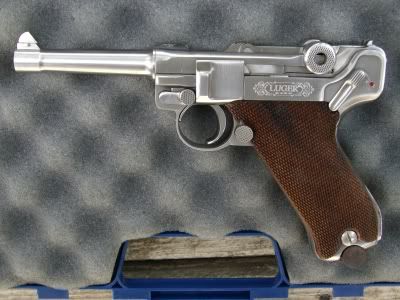Allow me to recommend another completely different ERMA in the .22LR caliber ... the Erma KGP69. This smaller Erma .22 is somewhat smaller than a P08, and alot more solid than the larger LA, EP etc. Ermas. Whereas the larger EP, La -type is a bit larger than a P08, this KGP69 Erma .22 has better proportions, much more Luger-like, and has some mechanical improvements on the larger Erma.
A true hold-open, identical operation to a P08, instead of the LA Erma's fake hold-open mechanism depending on the mag follower to catch the bolt. On a La Erma, provided that the hold-open does acutally succeed in working on any given expample, the bolt will slam shut when the magazine is pulled out, unlike the regular Luger system.
...The KGP69 Erma has a magazine safety, that acutally works well, with a different design than the failed P08 Police variant tried in the inter-war period. The KGP69 Erma mechanism has a small actuator in the frame that senses the round base of the inserted magazine, and blocks the trigger when the mag is removed.
... The KGP69 is made of better metal, denser steel maybe, seems tighter in fit, uses less alloy, than the LA -type models. The barrel, sliding extension and toggle train are blued steel, while the frame is steel that has some sort of paint finish, which seems more durable than the LA versions.
The improved internal design of the KGP69 (introduced in 1969 ?) gives it a better feel, and more reliability.
....I currently have four, and am keeping them. I think they are pretty good approaches to the German quality of the P08, scaled back for the .22 cal. and scaled down to the 3 to 5 hundred dollar price range.
....Parts availability is dwindling, and the most often needed replacement part, the extractor, has been the hardest to find. I returned one of these guns to the seller because it was missing the extractor, and I couldn't find those repacement parts. However the guns I have are holding up well, and are really satisfying to shoot. Fortunately, magazines come up frequently for sale online, both the original mfg. Erma branded ones with the black plastic base, and also Triple K mags, with silver aluminum bases. I think the Erma mags are better made, thicker metal, and better formed, but the sheet metal 3-K mags work fine aslo.
The take-down is a bit more difficult than a P08, with some oddly similar parts. Where the P08's take down lever is instead a rounded block that is removed from the KGP frame, which allows sliding the upper back, and then the rear axle pin is slid out of the toggle behind the frame, something a P08 doesn't do.
Then the toggle train can be pulled out the back, and the upper is slid all the way forward out of the frame. There are some typical Erma firinig pin and guide rods that were also held by the now removed axle pin. Re-assemly is the tricky part, getting the axle pin back thru the upper, the toggle link, and the two pins holes at the same time. I found that a tapered pilot pin was useful in lining everything up prior to putting in the axle pin.
It was after using the KGP69 Erma to sate my Luger .22 interest, that I was able to give up on the Erma conversion kits, and sold them finally (at no loss, fortunately) after some memorable attempts with springs etc. and going thru several kits, trying different combinations etc. Some members may recollect the threads, and had given me various encouragement and discouragement. The kits, good for collecting, but - shooting - 'forget that.
Beeman made (and still has available) some really nice wooden grips for this KGP69, which are an improvement over the standard plastic grips and without their thumb shelf, which is comfortable, but not in keeping with Luger style.
Erma also made an even smaller Luger copy as a .380ACP, (9 Kurz) and as a .32 cal. they being called KGP68 and KGP68a, not sure which is which. Not all parts are interchangable, of course, especially the grips, which are oddly just a bit larger on the .22 model KGP69. I have never had nor fired one of these centerfire KGP Ermas, but I have held one and seen several.










